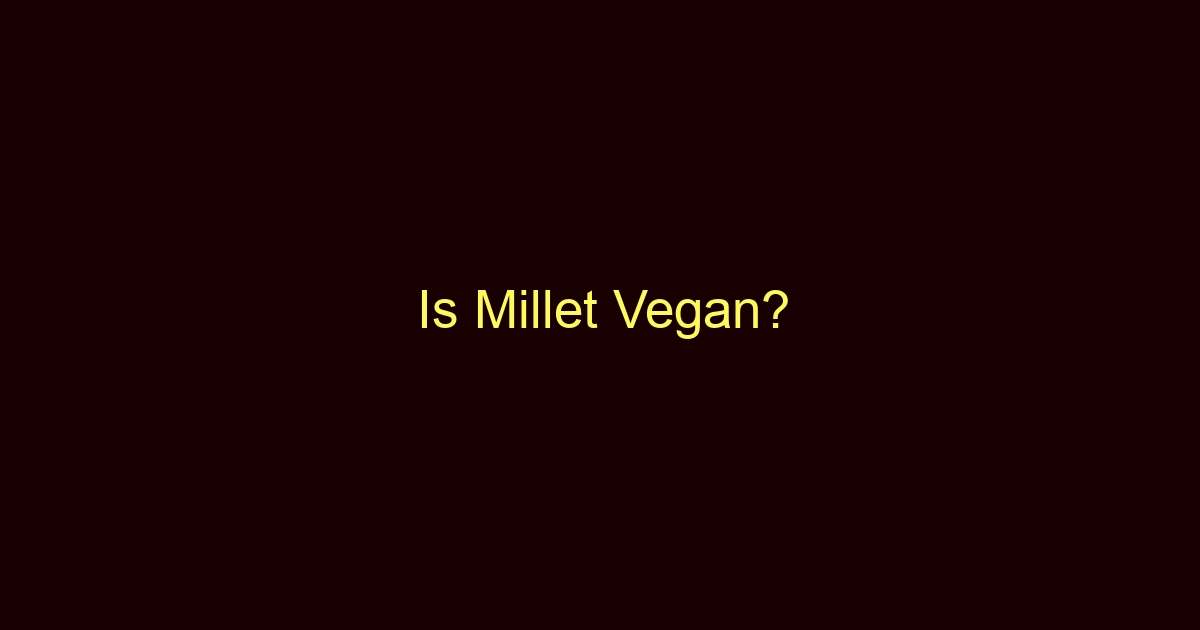Millet, a small-seeded cereal grain, has been gaining popularity in recent years as a nutritious, versatile, and gluten-free option for many recipes. As this interest grows, a question that often comes up is whether millet is vegan-friendly. Let’s dig deeper and discover more about this ancient grain.
What is Millet?
Millet is a term that encompasses several species of cereals and grains that are primarily grown in Asia and Africa. They are small-seeded grains that are hardy and drought-resistant, making them a reliable source of nutrition in arid regions. Millet has been a staple food for thousands of years, especially in India and Africa, and is known for its nutritional profile, being rich in vitamins, minerals, and fiber.
The grain is quite versatile and can be used in a variety of dishes, from savory to sweet. It can be used in everything from salads and soups to bread and desserts. But what exactly is millet made of?
What is Millet Made of?
Millet, as a plant-based food, is primarily composed of complex carbohydrates, with a good dose of protein, fiber, vitamins, and minerals. It contains several B vitamins, including niacin, thiamin, and riboflavin, and is also rich in the minerals magnesium, potassium, and phosphorus.
Most importantly, millet is gluten-free, making it a great alternative grain for those with celiac disease or gluten intolerance. It also contains antioxidants, which help protect the body against damage from harmful molecules called free radicals. Now, let’s discuss the uses of millet and where you might typically find it.
What is Millet Used For?
Millet is a highly versatile grain used in a variety of culinary applications. It can be cooked and used in place of rice or quinoa in dishes, used as a base for salads, or added to soups and stews. Ground millet flour is also a fantastic gluten-free option for baking.
What Foods Contain Millet?
Millet can be found in a wide range of food products. It’s often used in whole grain bread, multigrain cereals, and in gluten-free products. Additionally, millet is frequently used in dishes from cultures where it’s traditionally grown, such as India, where it’s used in roti (a type of flatbread), and Africa, where it’s used to make a thick porridge.
Is Millet Vegan?
Yes, millet is vegan. As a plant-based grain, it does not contain any animal products or byproducts, and its cultivation does not generally involve any animal-derived fertilizers or other inputs, making it a suitable option for those following a vegan lifestyle.
However, as with all foods, it’s always a good idea to check the ingredient list of any products containing millet to ensure no non-vegan additives or processing aids were used.
Can Vegans Eat Millet and Why?
Yes, vegans can absolutely include millet in their diet. As a plant-based grain, millet is not only free from animal products but also a fantastic source of nutrients. It provides a variety of essential vitamins and minerals, including magnesium, which is often harder to get in sufficient quantities from a vegan diet.
The versatility of millet makes it an easy grain to incorporate into a vegan diet, from using it as a substitute for rice to baking it into bread or using it in desserts.
Health Benefits of Millet
Millet is a nutrient-dense food, providing high amounts of fiber, B-vitamins, iron, magnesium, phosphorus, and manganese. The fiber in millet aids digestion and can help to lower cholesterol levels in the body.
As it is gluten-free, millet is a great grain option for people with celiac disease or those avoiding gluten for other reasons. The high protein content makes it a valuable addition to a vegan diet, providing essential amino acids.
Furthermore, millet has a low glycemic index (GI), which means it releases its energy slowly, helping to keep blood sugar levels stable, which is beneficial for people with diabetes.
Downsides of Millet
While millet is generally a healthy grain, it does contain goitrogens. These are substances that can interfere with the functioning of the thyroid gland by inhibiting iodine absorption. However, this is generally only a concern when consuming millet in very high amounts and with an already low iodine intake.
Cooking, soaking, or fermenting millet can also reduce its goitrogenic properties. As with all foods, it’s about balance. Including millet as part of a varied diet is unlikely to cause issues.
How to Include Millet in Your Diet
Incorporating millet into your diet can be easy and delicious. It can be cooked and used as a base for salads, added to stews and soups, or ground into a flour for gluten-free baking. You can even make a sweet breakfast porridge with millet, similar to oatmeal.
If you’re new to millet, start by replacing rice or quinoa with it in your favorite dishes. It has a mild, slightly nutty flavor that pairs well with a variety of foods.
Is Millet Safe?
Millet is safe for most people to eat. However, as mentioned earlier, due to its goitrogen content, people with thyroid problems should be careful with their millet consumption, especially if their iodine intake is low. As always, if you have any health concerns, it’s best to consult a healthcare provider.
Final Thoughts
Millet is definitely vegan-friendly. This nutritious, gluten-free grain is a fantastic addition to a vegan diet, providing many essential nutrients, including high-quality plant protein.
While millet contains goitrogens, which could interfere with thyroid function, this is generally not a concern unless it’s consumed in very large amounts and iodine intake is insufficient. Cooking, soaking, or fermenting millet can reduce these goitrogenic properties.

